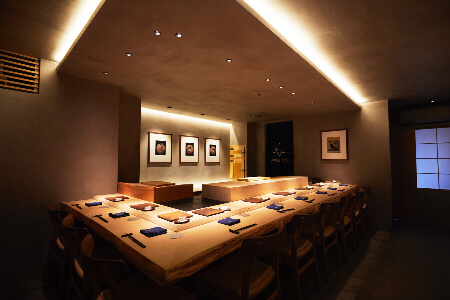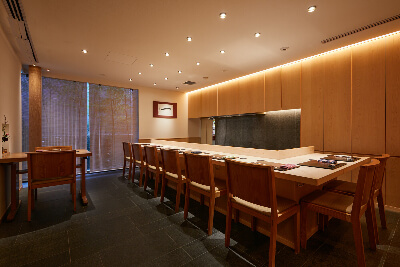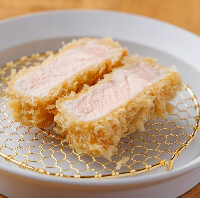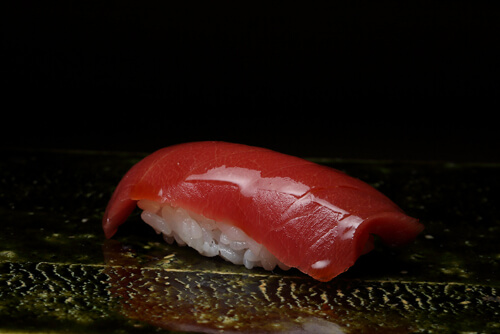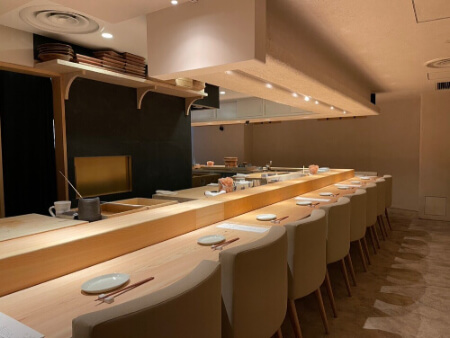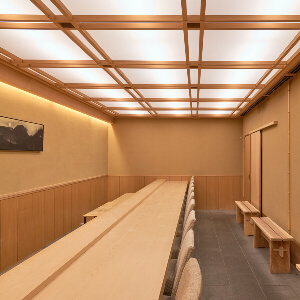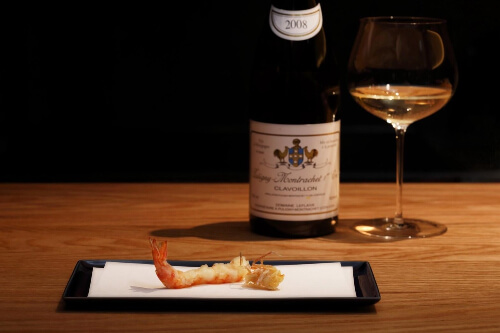Ramen
Ramen (āēü[āüāō) is a noodle soup dish that was originally imported from China and has become one of the most popular dishes in Japan in recent decades. Ramen are inexpensive and widely available, two factors that also make them an ideal option for budget travelers. Ramen restaurants, or ramen-ya, can be found in virtually every corner of the country and produce countless regional variations of this common noodle dish.
Popular ramen types
Ramen are typically categorized according to their soup base, although variations that combine the different bases are not uncommon. The main types of soup are:




Ramen noodles
The second key aspect of ramen are the noodles, which are made of wheat and come in many different types. Typical ramen noodles are long and elastic, but countless varieties exist that vary from thin and straight to thick and wavy. Some ramen-ya allow you to customize your noodle order to some extent such as by allowing you to select a thickness (thin, regular or thick) or doneness (regular or firm).
Toppings
Below is a list of toppings that are commonly served with ramen:
- Chashu
![]()
Fatty slices of roasted or braised pork. Chashu is a very common topping, and standard bowls of ramen usually come with one or two slices of it. Most ramen-ya also serve Chashumen (chashu ramen) which is a ramen dish with additional pieces of chashu. Kakuni (braised pork belly) is served instead of chashu at some restaurants. - Menma
Preserved bamboo shoots with a salty flavor - Negi
Chopped or shredded leeks or green onions. Karanegi is a spicy variation of shredded leeks mixed with chili oil. Negi is a ramen standard, while karanegi is often seen with miso ramen. - Moyashi
Raw or cooked bean sprouts add sweetness and crunch. Served on all types of ramen. - Tamago
Hard boiled, soft boiled, raw and marinated eggs are all popular toppings on any type of ramen. - Seaweed
Various types of seaweed such as wakame and nori are commonly added to all types of ramen. - Kamaboko
Slices of steamed fish cake. One type of kamaboko that is commonly served on ramen is naruto (or narutomaki), a sawtooth edged, white fish cake with a pink spiral design on it. - Corn
Canned corn is often paired with butter and served on miso or shio ramen. - Butter
A thick pat of butter adds creaminess and depth. Typically added to miso or shio ramen.


Side dishes
Though ramen can be considered a one dish meal, many ramen-ya also serve a selection of side dishes in addition to their noodles. The offerings vary from shop to shop but virtually all ramen-ya serve gyoza (potstickers). These Chinese-style, pan fried dumplings come five or six to an order and are eaten after being dipped in a mixture of soy sauce, vinegar and rayu (hot chili oil), all of which are usually available on the table and combined according to your taste. And of course, nothing complements a steaming hot bowl of ramen like an ice cold beer.
Some shops also offer set deals that include ramen, gyoza and sometimes other dishes such as fried rice or drinks. These sets are sometimes sold at a slightly discounted price compared to ordering everything separately.

Where to find ramen
The best place to eat ramen is at specialized ramen restaurants, the aforementioned ramen-ya, which are commonly found around busy locations such as train stations, entertainment districts and along busy roads. Ramen-ya are usually sit-down restaurants with a counter and some tables, although smaller ones may only have a single counter. In busier locations, some ramen-ya may only offer standing counter space.
Ramen are also often featured on the menus of other restaurants that serve a wider range of dishes such as common eateries found at tourist sites, izakaya, family restaurants and food stalls. Hot ramen dishes can also be purchased around the clock at convenience stores and at some vending machines.
How to order
Typical ramen-ya tend to follow the procedures described on our dining out page, with the additional note that it is fairly common for ramen-ya to use the vending machine method for ordering and paying. In these cases you should purchase meal tickets at the machine near the entrance before being seated.

How to eat
Ramen are eaten with chopsticks which are usually available at the table. A Chinese-style spoon is often provided as well to help with small toppings and for drinking the soup. It is also alright to lift up the bowl to drink the soup directly from the bowl.
Ramen noodles get soggy quickly and should be eaten immediately after they are served. As with other noodle dishes in Japan, a slurping sound is made when eating ramen. The slurping enhances the flavors and helps cool down the piping hot noodles as they enter your mouth. At the end of the meal, it is alright to leave some unfinished soup in the bowl. You do not need to drink the whole bowl to be polite, although it is considered a compliment to the chef to do so.

Ramen-related attractions
Regional varieties
Ramen are also available in many regional varieties, some of which have become so popular that they are now found nationwide. A few of the best known regional varieties are:
Instant ramen
Ramen are also available in several prepared forms that are quick and easy to make at home or in your hotel room. A wide range of instant ramen products are sold in cups and packets at supermarket, convenience store and some vending machines. The simplest require only the addition of hot water, which is sometimes supplied at the store or machine where they are sold. Hotels in Japan almost always provide a hot water pot on their rooms, making these types of instant ramen an easy, hot meal choice for tourists, as well.
There are also various types of fresh ramen and ramen toppings sold at Japanese grocery stores. These are fast and easy to make too, but require a little more time to prepare than the instant varieties as the noodles do not come precooked. In addition to boiling the noodles, you must also make the soup from the concentrated soup base included with the noodles and your desired toppings. Despite this extra bit of effort, these products make it possible to enjoy restaurant quality ramen conveniently at your own home.

Questions? Ask in our forum.
Restaurants
-
-
![]() Udatsu Sushi (Tokyo)Awarded One Star in 2024 - People from around the world visit to experience Mr. Udatsu's sushi. Inside the restaurant, which resembles an art gallery with its modern decor and numerous artworks, guests can enjoy sushi crafted from the highest quality ingredients. While the foundation is traditional nigiri, the menu also features original creations born from the chef's relentless curiosity and innovation.View on JapanEatinerary
Udatsu Sushi (Tokyo)Awarded One Star in 2024 - People from around the world visit to experience Mr. Udatsu's sushi. Inside the restaurant, which resembles an art gallery with its modern decor and numerous artworks, guests can enjoy sushi crafted from the highest quality ingredients. While the foundation is traditional nigiri, the menu also features original creations born from the chef's relentless curiosity and innovation.View on JapanEatinerary -
![]() Waketokuyama (Tokyo)Awarded One Star in 2025 - With a meticulous focus on allowing guests to enjoy seasonal ingredients at their peak, the menu changes approximately every two weeks. The signature dish, "Grilled Abalone with Seaweed Aroma," features thick slices of abalone generously coated in a rich liver sauce, offering an exquisite taste of the sea.View on JapanEatinerary
Waketokuyama (Tokyo)Awarded One Star in 2025 - With a meticulous focus on allowing guests to enjoy seasonal ingredients at their peak, the menu changes approximately every two weeks. The signature dish, "Grilled Abalone with Seaweed Aroma," features thick slices of abalone generously coated in a rich liver sauce, offering an exquisite taste of the sea.View on JapanEatinerary -
![]() Sushiroku (Osaka)Awarded One Star in 2024 - A cozy, family-run restaurant managed by a husband and wife. They are deeply committed to perfecting their shari (sushi rice) and use two types of vinegared rice tailored to complement each topping. Since 2019, the restaurant has consistently earned stars.View on JapanEatinerary
Sushiroku (Osaka)Awarded One Star in 2024 - A cozy, family-run restaurant managed by a husband and wife. They are deeply committed to perfecting their shari (sushi rice) and use two types of vinegared rice tailored to complement each topping. Since 2019, the restaurant has consistently earned stars.View on JapanEatinerary -
![]() Fry-ya (Tokyo)Exquisite fried dishes crafted by a head chef with experience earning stars in both Switzerland and Japan. The remarkably light tonkatsu is a favorite not only among Japanese diners but also among visitors to Japan. With the theme of "small portions, many varieties," guests can enjoy sampling a wide selection of tonkatsu in smaller portions.View on JapanEatinerary
Fry-ya (Tokyo)Exquisite fried dishes crafted by a head chef with experience earning stars in both Switzerland and Japan. The remarkably light tonkatsu is a favorite not only among Japanese diners but also among visitors to Japan. With the theme of "small portions, many varieties," guests can enjoy sampling a wide selection of tonkatsu in smaller portions.View on JapanEatinerary -
![]() Sushi Hayashi (Kyoto)Awarded One Star in 2024 - A unique sushi restaurant that blends traditional Edomae (Tokyo-style) sushi with Kyoto-style sushi, such as mackerel sushi and steamed sushi, in its courses. The head chef, who trained as a sushi artisan in Switzerland, carefully selects Swiss wines, making them a perfect pairing to enjoy with the meal.View on JapanEatinerary
Sushi Hayashi (Kyoto)Awarded One Star in 2024 - A unique sushi restaurant that blends traditional Edomae (Tokyo-style) sushi with Kyoto-style sushi, such as mackerel sushi and steamed sushi, in its courses. The head chef, who trained as a sushi artisan in Switzerland, carefully selects Swiss wines, making them a perfect pairing to enjoy with the meal.View on JapanEatinerary -
![]() Hikarimono (Tokyo)With a prime location and quality that rivals high-end sushi restaurants, this restaurant maintains the goal of being a place for everyday dining. It offers a casual and relaxed atmosphere, free from stiffness or formality. The signature "Hikari-maki," featuring ingredients such as sardines, pickled plum, and bettarazuke (sweet pickled radish), boasts unique flavors that are especially popular among international visitors.View on JapanEatinerary
Hikarimono (Tokyo)With a prime location and quality that rivals high-end sushi restaurants, this restaurant maintains the goal of being a place for everyday dining. It offers a casual and relaxed atmosphere, free from stiffness or formality. The signature "Hikari-maki," featuring ingredients such as sardines, pickled plum, and bettarazuke (sweet pickled radish), boasts unique flavors that are especially popular among international visitors.View on JapanEatinerary -
![]() Noguchi Tsunagu (Kyoto)Awarded One Star in 2024 - The sister restaurant of the highly exclusive Japanese cuisine establishment, Kyotenjin Noguchi. While maintaining the culinary essence of the main branch, this kappo-style restaurant incorporates ingredients from the chefŌĆÖs hometown in the Goto Islands. Its signature dish, Nikusui, is a masterpiece made from carefully prepared, top-quality A5-grade sirloin.View on JapanEatinerary
Noguchi Tsunagu (Kyoto)Awarded One Star in 2024 - The sister restaurant of the highly exclusive Japanese cuisine establishment, Kyotenjin Noguchi. While maintaining the culinary essence of the main branch, this kappo-style restaurant incorporates ingredients from the chefŌĆÖs hometown in the Goto Islands. Its signature dish, Nikusui, is a masterpiece made from carefully prepared, top-quality A5-grade sirloin.View on JapanEatinerary -
![]() TEMPURA & WINE SHINO (Tokyo)The kind of restaurant that is known only to true gourmets, serving as a sort of 'Hidden gem'. In a chic space with black walls and a ceiling adorned in gold, you can enjoy tempura with a light and elegant texture, delicately fried using refined techniques to achieve a thin, white batter that minimizes the aroma of oil. Savor tempura that maximizes the flavors of the ingredients, paired with Champagne and Burgundy wines carefully selected by the sommelier.View on JapanEatinerary
TEMPURA & WINE SHINO (Tokyo)The kind of restaurant that is known only to true gourmets, serving as a sort of 'Hidden gem'. In a chic space with black walls and a ceiling adorned in gold, you can enjoy tempura with a light and elegant texture, delicately fried using refined techniques to achieve a thin, white batter that minimizes the aroma of oil. Savor tempura that maximizes the flavors of the ingredients, paired with Champagne and Burgundy wines carefully selected by the sommelier.View on JapanEatinerary -
![]() Ginza Nominokoji Yamagishi (Tokyo)Tominokoji Yamagishi, an exclusive kaiseki restaurant from Kyoto, has opened its first location in Tokyo. Unlike its main branch, this establishment adopts an izakaya-style format, allowing diners to enjoy a more relaxed ├Ā la carte dining experience. Despite being located in Tokyo, the restaurant meticulously sources ingredients and even water from Kyoto, dedicating itself to faithfully recreating KyotoŌĆÖs culinary traditions.View on JapanEatinerary
Ginza Nominokoji Yamagishi (Tokyo)Tominokoji Yamagishi, an exclusive kaiseki restaurant from Kyoto, has opened its first location in Tokyo. Unlike its main branch, this establishment adopts an izakaya-style format, allowing diners to enjoy a more relaxed ├Ā la carte dining experience. Despite being located in Tokyo, the restaurant meticulously sources ingredients and even water from Kyoto, dedicating itself to faithfully recreating KyotoŌĆÖs culinary traditions.View on JapanEatinerary -
![]() Kitashinchi Kushikatsu Bon (Osaka)A restaurant that elevates Osaka's soul food, kushikatsu, to a luxurious level. Skilled chefs meticulously prepare each skewer using carefully selected premium ingredients such as Chateaubriand and foie gras. The skewers are fried in a custom copper pot using a unique oil blend based on cottonseed oil, enhancing the natural flavors of the ingredients.View on JapanEatinerary
Kitashinchi Kushikatsu Bon (Osaka)A restaurant that elevates Osaka's soul food, kushikatsu, to a luxurious level. Skilled chefs meticulously prepare each skewer using carefully selected premium ingredients such as Chateaubriand and foie gras. The skewers are fried in a custom copper pot using a unique oil blend based on cottonseed oil, enhancing the natural flavors of the ingredients.View on JapanEatinerary
-












